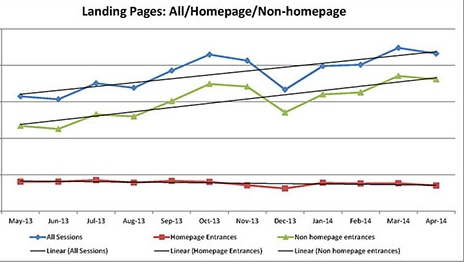The New York Times’ “Innovation” Report — which I commented on in a recent post — had one observation I immediately translated to my own organization because, like much in the report, this one touched on the differing concepts of site design, which in the case of the New York Times seems to correspond to a simmering tension between editorial and digital cultures. It’s a simple and common observation, which boils down to this — traffic to the home page (or “front page” for the New York Times) is flat or declining, because most people go straight to the articles they’re after from search or social.
After reading this section of the Times’ report, I asked my data analyst and jack of all trades to analyze our landing page traffic, comparing home page to all other pages. The result is below:
 As you can see, home page traffic (red line) is flat or declining, while entrances to non-home page pages is increasing. This is a long-term trend driven by Web 2.0 behaviors — search, social media, and social sharing. The other lines are growing faster than we are adding new content pages, so this is a traffic-based phenomenon. And, again, these are “entrances,” meaning where users first land.
As you can see, home page traffic (red line) is flat or declining, while entrances to non-home page pages is increasing. This is a long-term trend driven by Web 2.0 behaviors — search, social media, and social sharing. The other lines are growing faster than we are adding new content pages, so this is a traffic-based phenomenon. And, again, these are “entrances,” meaning where users first land.
This observation is important for a variety of reasons, and based on casual discussions with colleagues recently, it is not commonly known. This may be because people still think of sites as an assortment of directories or pages — i.e., the home page is a directory/page, the search page is a directory, and so forth. Making this assumption would likely show that the home page is the most-trafficked page. But this would conceal a more important insight about traffic.
The consequences of knowing this are many. First, designing the home page with the fussiness we often demand isn’t nearly as important as imagined. Second, for journals with advertising, keeping ads off article pages is clearly bad for business, as traffic drives advertising. Many advertising policies limit ads to the home page and similar aggregated pages, yet the real growth in traffic is at the article level. Third, article pages are the entry points for the majority of visitors, so their designs may need a rethink. And there is a fourth implication I’ll cover after a little more hand-wringing.
This trend has been known in our community by some, including leaders at the major platform providers, who have advised publishers to treat their article pages as landing pages. But editors generally aren’t aligned with this notion, if my observations are accurate. What I hear from other publishers is that editors still have a model of site architecture that is very Web 1.0 — a home page that everyone starts at, followed by pages they link to from browsing the home page contents. This also can lead to a hyperfocus on native search capabilities, a symptom of a similar “it all starts at the home page” mentality.
The fourth implication is about email, the neglected stepchild of online publishing and the source of the oft-neglected “dark social” traffic we all find hard to explain. For years, I’ve been urging platform providers, editors, and others to pay attention to their emails. They drive traffic. Static article lists don’t amount to sophisticated content marketing. And there’s a lot of room for improvement here. But even in their neglected state, emails send a lot of traffic to our sites — but at the article level, once again. One could plausibly argue that the design of your emails is more important to content discovery and content marketing than the design of your home page.
I’ll say it again — the design of your emails is probably more important than the design of your home page.
I say this as a hypocrite myself, having concentrated on page design far more than email design. But I hope to be a recovering hypocrite in this regard, thanks to this chart’s reminder of what truly drives traffic — and it’s not the home page.
As I wrote about recently, publishers are to a large extent “content marketers.” The brands we build and manage, the prestige we convey, the distribution we achieve, and the authors we attract are major parts of the content marketing platform. Search engine optimization (SEO), email delivery, social media, and licensing to trusted third parties are significant parts of content marketing, as well. Designing a home page is farther down the list, and should come after all the other aspects of your content marketing platform are built.
Check with your analytics people. Compare traffic to your home page to traffic to the rest of your site. You may be in for a surprise or two.
Discussion
11 Thoughts on "Contemplating a Chart — How the Home Page Dominates Thinking . . . and Little Else"
Does this apply to the journal home page? Is that over done? Is everything now at the article level – is that where we should focus – or at least rebalance – branding (somehow)?
The implications seem greater than just email design.
The big design question then becomes how to move people from the article landing page to other content. Here the “more like this” feature is paramount. Some sites do this well, others not well at all and some not at all. I was recently at a major site, asked for more like this for an article and was given 600 hits. Worthless. The quality of more like this depends on the ranking algorithm, which is a science in itself. Evaluating this algorithm is arguably more important than designing the homepage.
Reference lists are de facto “more like this” features. This is another area publishers have overlooked, as we found in creating SocialCite. Nobody knows how many clicks are occurring on their reference lists. It’s a surprisingly high number.
I am not sure what you mean by a reference list. If you mean the article’s citations they are unlikely to ever provide a good more like this list. If there are even just a few journals and a sizeable backlist then a computer based algorithmic approach is the only way to do more like this well. And of course citations are never forward looking, but we want more like this to find articles that come later than the landing article, which we now know may be years old. Thus the more like this list is constantly changing as new articles are added. I have done a lot of research on this and it is a major challenge. It is basically an artificial intelligence problem and a lot of people are working on it. And yes it is more important than homepage design.
Thanks for a timely article! We are in the process of redesigning one of our websites and the plan was to include the homepage as a top priority in the redesign. I am now going to revisit that plan!
Reblogged this on Kristi Bruno and commented:
Content, content, content. Say it with me now!
A quick linear regression to the total data (from pixel values) yields a correlation coefficient ρ = 0.09, i.e., there’s no real linear trend here.
Oh, dear, that’s the autocorrelation rho. Cue Emily Litella.
(The correct value is r = 0.789. Sorry ’bout that.)
Yes, this is all most certainly true. But it also may be true that your homepage is the single most visited page of your site, and it may be the single most popular landing page on your site. Those visits are however far, far outweighed by the visits to your article pages collectively. So, while your first priority should be getting the best template for your article pages, the homepage should not be a mere afterthought.
Different segments of your audience enter in different ways. A current or prospective author, a prospective subscriber, or a prospective advertiser are more likely to enter on your homepage. Whatever you do on that page ought to reflect users who are seeking out the journal, rather than the article.


